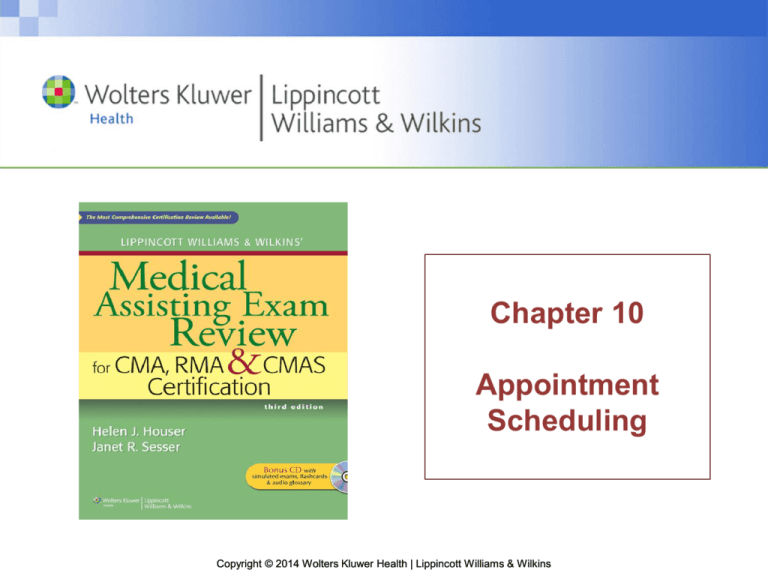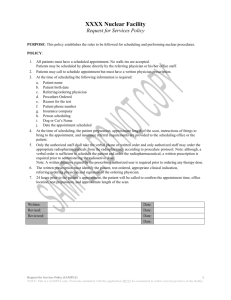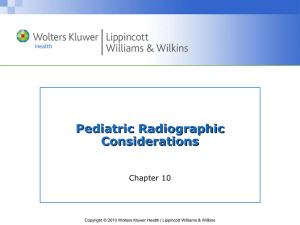PPT_Chapter_10_Appointment Scheduling
advertisement

Chapter 10 Appointment Scheduling Copyright © 2014 Wolters Kluwer Health | Lippincott Williams & Wilkins Review Tip Keep energized! This review process, even if it seems grueling, is a relatively short period of time with an end in sight. Go outside and enjoy a walk or run or just sit on a park bench and clear your head. Call someone you can count on to be cheerful. Read some jokes or inspirational pieces. To regain your focus and energy, do something that usually makes you feel good! Copyright © 2014 Wolters Kluwer Health | Lippincott Williams & Wilkins Overview The goal of appointment scheduling is to maintain a smooth office flow while accommodating the needs of the medical practice and the patient. The type of scheduling used depends on the following: Nature of practice ■ Patient population needs ■ Doctor’s preferences and habits ■ Available facilities and staff ■ Copyright © 2014 Wolters Kluwer Health | Lippincott Williams & Wilkins Types of Scheduling The exam questions will require you to identify the different types of scheduling. These types include: ■ Open hours (tidal wave, open booking)—no appointments needed; first-come, first-served. • Used primarily in urgent care centers • Eliminates broken appointments • Limits medical records and procedures preparation • Prohibits control of number of patients arriving at one time • Needs triage system Copyright © 2014 Wolters Kluwer Health | Lippincott Williams & Wilkins Types of Scheduling, cont’d. Clustering (group procedures, categorizing)—similar procedures scheduled on predetermined days or in predetermined time blocks, such as new patient exams, sports physicals, and immunizations; they are designated when the appointment book matrix is developed • Increases efficiency and speed for procedures • Theoretically, allows better utilization of equipment and staff ■ Select scheduling • Double booking—two or more patients scheduled at the same time - Used by practices with short visits or a high no-show rate - Increases patient waiting time - Reduces physician downtime ■ Copyright © 2014 Wolters Kluwer Health | Lippincott Williams & Wilkins Types of Scheduling, cont’d. • Wave—a specific number of patients, usually four, scheduled at the beginning of the same hour - Reduces physician downtime - Allows specific procedures, such as a routine ECG, to be performed prior to the physician seeing the patient - Intended to start and finish each hour on time - Increases waiting for patients seen later in the hour - Creates issues of who is seen first if more than one person arrives at the same time • Modified wave—hour-long blocks broken down to smaller time increments (usually 10 or 15 minutes each) and individual patients scheduled within those increments - Intended to start and finish each hour on time - Decreases patient waiting time compared with wave scheduling - Avoids issues of who should be seen first Copyright © 2014 Wolters Kluwer Health | Lippincott Williams & Wilkins Types of Scheduling, cont’d. • Time-specific (streaming)—patient given an appointment based on length of time needed and on available time; this is the most common scheduling method ■ Other scheduling considerations • Physician or office delay—keep patients informed of waiting time; offer opportunity to reschedule or wait • Time allotment for visits and procedures—established criteria indicate the time required for the common procedures and visits in a practice (e.g., a complete physical exam may be 45 minutes, suture removal may be 15 minutes); new patients are usually allotted more time than established patients • Emergencies—office criteria for handling urgent medical situations in the office and on the telephone, including involvement of the emergency medical system and poison control centers Copyright © 2014 Wolters Kluwer Health | Lippincott Williams & Wilkins Types of Scheduling, cont’d. • “Walk-ins”—patients who come to the office without an appointment expecting to be seen; urgency and available appointment time should be considered • Referrals—urgency of referrals should be communicated by the referring physician, and appropriate medical records, including diagnostic results, should be sent to the consulting physician • Repeat appointments—schedule patients for a series of appointments (e.g., dressing changes, antibiotic administration) at the same time on the same day of the week, if possible; this reduces the incidence of missed appointments • Flexible hours—varied hours on certain days; may include evenings and weekends • Buffer zone—periods during the day with no appointments scheduled to accommodate emergencies and to allow the physician to catch up if running late Copyright © 2014 Wolters Kluwer Health | Lippincott Williams & Wilkins Types of Scheduling, cont’d. • Sales representatives—the norm has become to give sales representatives, such as with pharmaceutical companies, a designated appointment or to have a specific day or time of the day set aside for these visits • Other visitors—attorneys, and other nonmedical professionals may request to meet with the physician to function as expert witnesses or perform other consulting- type services; appointments are scheduled to accommodate the physician and the practice; these services are generally billed Copyright © 2014 Wolters Kluwer Health | Lippincott Williams & Wilkins Types of Scheduling, cont’d. Copyright © 2014 Wolters Kluwer Health | Lippincott Williams & Wilkins Equipment and Materials ■ Appointment book—specially designed calendar-type book used to schedule appointments • Remains open and conforms to desk or counter space size • Conforms to Health Insurance Portability and Accountability Act (HIPAA) privacy standards; not able to be seen by unauthorized people • Accommodates practice (e.g., it has an adequate number of lines for the number of physicians) ■ Daily log—separate from the appointment book; a ledger-type book listing the day’s appointments and used for cross-referencing financial entries, data collection on types and number of procedures, and total patients seen Copyright © 2014 Wolters Kluwer Health | Lippincott Williams & Wilkins Equipment and Materials, cont’d. Worksheet—copy of daily patients by list or medical assistant assignment; used to prepare rooms and equipment; it is shredded at the end of the day in compliance with HIPAA privacy standards ■ Computer appointment scheduling—software that replaces the hard-copy appointment book • Commercial or custom software can be used (it may also incorporate financial and claims procedures) • Legal, HIPAA, and other standard appointment guidelines must be met ■ Copyright © 2014 Wolters Kluwer Health | Lippincott Williams & Wilkins Procedure ■ Developing the matrix—preparing the appointment book or computer to show what times are available and unavailable for appointments • Block off times when appointments are not routinely scheduled, such as lunch or monthly staff meetings • Fill in physician’s time away from the office, such as for hospital rounds, out-of-office procedures, or meetings • If the cluster method of scheduling is used, mark days and times that are reserved for special procedures (e.g., if Mondays are reserved for sports physicals, the top of the day’s matrix would be marked “sports physicals” and times would be blocked in the increments designated by the practice for each physical) Copyright © 2014 Wolters Kluwer Health | Lippincott Williams & Wilkins Procedure, cont’d. ■ Scheduling • Begin with the first appointment available that has the time required for the specific visit • Consider patient and practice needs, such as fasting for blood work, preparation for procedures, or who does specific procedure • Obtain patient’s full name and telephone number • Note reason for visit, using standard abbreviations Copyright © 2014 Wolters Kluwer Health | Lippincott Williams & Wilkins Procedure, cont’d. Copyright © 2014 Wolters Kluwer Health | Lippincott Williams & Wilkins Patient Preparation At the time the appointment is made: Verify that the office accepts the patient’s insurance ■ Inform the patient of any copay and other office financial policies ■ Instruct the patient to bring his or her insurance card and any necessary insurance forms, medical records, and immunization records ■ Request that a new patient allow time before an appointment to complete registration material in the office ■ Provide directions to office ■ Mail preregistration material if it is office policy to do so ■ Obtain prior approval from the insurance company if required ■ Explain any necessary preparations for procedures both verbally and in writing ■ Confirm date and time of appointment at the end of conversation ■ Copyright © 2014 Wolters Kluwer Health | Lippincott Williams & Wilkins Procedures Outside of the Practice Depending on the type of practice, it may be necessary to schedule hospitalizations and procedures to be performed outside of the medical office. The following are guidelines: ■ Inpatient scheduling for an illness or procedure that requires a hospital stay: • Ensure insurance requirements, such as prior authorization, are met • Check patient’s availability for expected length of stay (LOS) • Check physician’s availability for procedure • Know appropriate diagnosis (ICD-9 code) and procedure (CPT code) • If surgery or procedure, schedule with appropriate department within the hospital Copyright © 2014 Wolters Kluwer Health | Lippincott Williams & Wilkins Procedures Outside of the Practice, cont’d. • Schedule the admission or reservation with the hospital Admissions Department (separate from scheduling the procedure to assure a bed is available on the appropriate unit afterward) • Provide patient preparation information and materials if appropriate ■ Outpatient scheduling for a procedure that does not require a hospital stay: • Ensure insurance requirements, such as prior authorization, are met • Check patient’s availability • Check physician’s availability for procedure • Know appropriate diagnosis (ICD-9 code) and procedure (CPT code) • Schedule with appropriate facility • Provide patient preparation information and materials if appropriate Copyright © 2014 Wolters Kluwer Health | Lippincott Williams & Wilkins Appointment Reminders ■ Appointment cards—given at the time the appointment is established ■ Tickler file—an index system with cards placed in chronologic order, usually by week or month; used as reminders for items that need attention in the future, such as immunizations ■ Reminder mailings—cards or computer-generated forms mailed to the patient informing him or her that an appointment is coming up or to remind the patient to call and schedule an appointment if the patient is due for a procedure (e.g., annual well-woman check) ■ Telephone calls—made by the office the day before the appointment is scheduled; leave messages only with prior patient permission (usually obtained during initial registration) ■ E-mail—sent with patient’s permission ■ Recall notices—cards or computer-generated forms sent to inform the patient that he or she missed a scheduled appointment or that he or she is overdue for a procedure (e.g., immunizations) Copyright © 2014 Wolters Kluwer Health | Lippincott Williams & Wilkins Patient Flow Analysis Patient flow analysis is a periodic study conducted by the medical practice to assess the efficiency of scheduling and staff and, ideally, resolve identified problems. It generally measures the following times: Sign in ■ Scheduled appointment ■ Placement in treatment room ■ Physician presentation ■ Discharge ■ The times are then evaluated and compared with established norms and benchmarks. Some insurance companies require or recommend a patient flow analysis at intervals or may conduct one as a follow-up to member complaints or other issues. Copyright © 2014 Wolters Kluwer Health | Lippincott Williams & Wilkins Legal Issues ■ Treat the appointment book and daily log as legal documents; they may be subpoenaed ■ Maintain HIPAA standards by ensuring confidentiality with appointment information; if the system is computerized, screens should be protected from view, passwords changed frequently, and required firewalls in place if the system is part of a network ■ Document no-shows and cancellations that are not rescheduled in the patient’s medical record and in the appointment book and log Copyright © 2014 Wolters Kluwer Health | Lippincott Williams & Wilkins







